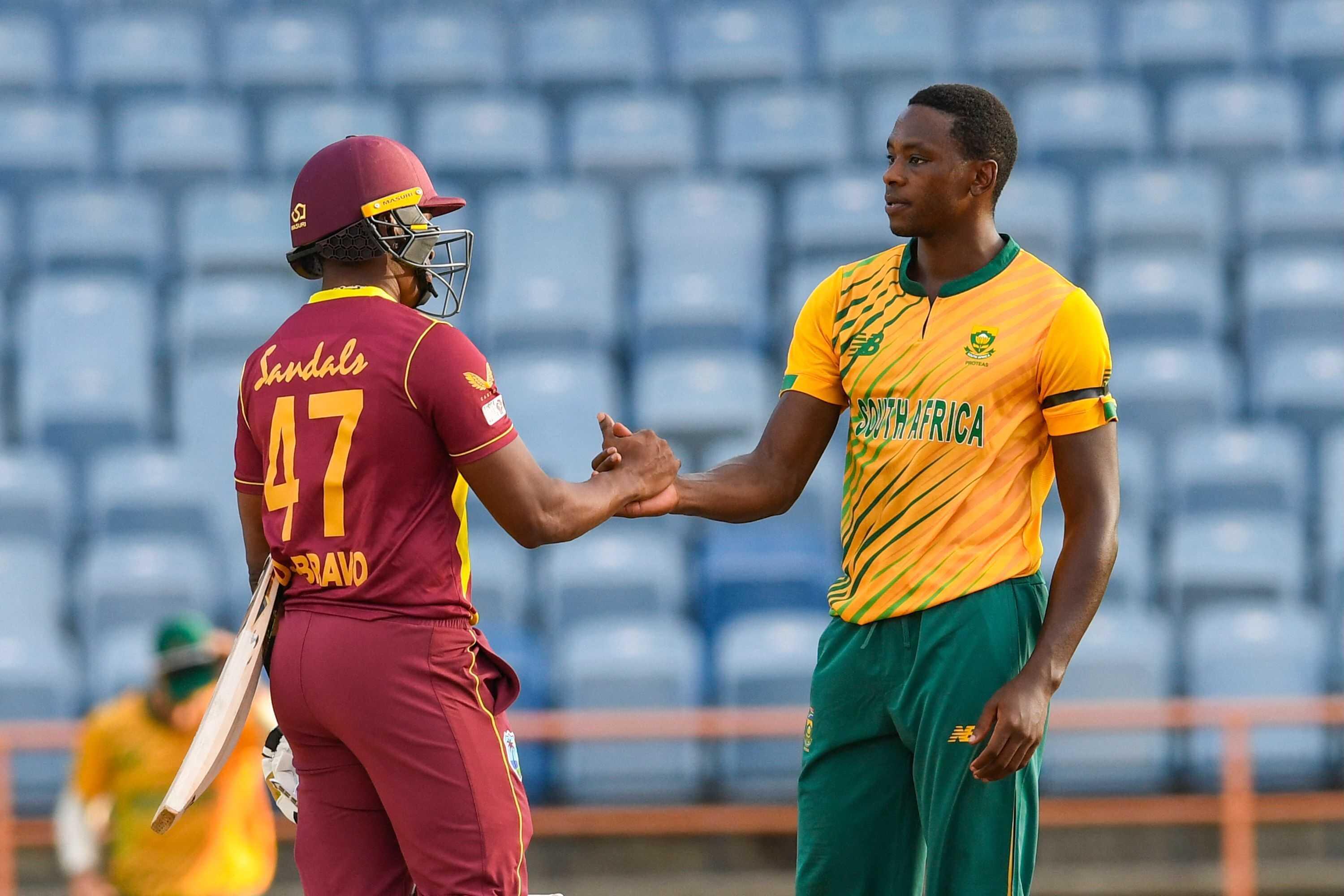Despite the away win in the Caribbean, South Africa have some glaring issues to fix
Phew, after a long drama, after five to-and-fro T20Is, South Africa finally clinched the series in a dramatic fashion to end their terrible away form. However, while the Proteas might be celebrating, there are some glaring issues that need to be addressed before the World T20 kicks off in October.

Skipper Temba Bavuma and his dreaded form
Leading from the front, Temba Bavuma stood strong as a leader on the field, providing his backing to the bowlers, to the spinners and changing the bowlers in the best possible manner. Not only did he lead the team to a crucial away win in the West Indies but also ensured that his leadership abilities were not questioned. However, that opened the door for criticism elsewhere, rightly so. His form with the bat is a major concern and a ‘largely unknown’ mystery for South African cricket. Having just played eight T20Is, the Proteas decided that he was going to be their skipper for the World T20 in October.
Going into his second year, Bavuma had averaged 76 with the bat in the shortest format, having scored 49 and 27* against India. In his second year, barring the two dismissal knocks - 5 and 13 - Bavuma ended up averaging 28.83, at a good strike rate of 142.97. So when the West Indies series was around the corner, they expected the better Bavuma to turn up. However, that’s where the expectations started to falter, with scores of 22, 46, 1, 7 and 0 in the series. Barring the 46, which came off 33 deliveries, at a strike rate of 139.9, all of his knocks have been at a horrifyingly slow rate. Having started the series at No.3, he ended the series as an opener, all of it in vain. So before the World T20, Bavuma really needs a step up, ideally at No.3 but morally, anywhere in the batting order.
Aiden Markram’s dazzling form needs a permanent fixture
Let’s face it, Aiden Markram with the bat gave more hope to the fans than David Miller or Temba Bavuma did in the entire series. In fact, having just played the three games, the right-handed top-order batsman scored 113 runs, finishing only behind Quinton de Kock in terms of top run-scorer for the Proteas, at a remarkable strike rate of 131.39. Even if you remove his shambolic bowling out of the picture, you have a batsman, who understands the need of the evolving T20 game and arguably, has all the shots to master it. Just prior to the series against West Indies, in Pakistan, Markram put on a spectacle for the Proteas, scoring 179 runs in four games, averaging 44.75 and at a strike rate of 182.65, all of it opening the batting.
However, in the West Indies series, first due to Reeza Hendricks and later Bavuma, Markram had to make his way in the middle-order, at No.4 and 3. Even when the challenge was monumental, the right-hander did not bow out, scoring 23, 20 and later, a match-winning knock of 70 off just 48 deliveries. Throughout the series, he showed keen interest in getting the boundaries and running the runs. While South Africa might have used him as a middle-order batsman, his best might just come at the top, something that they should start pondering about!
South Africa’s spin-bowling worries, finally sorted
Oh boy, South Africa have hit home in a lot of departments in the series against West Indies and most importantly, in the spin department. Against West Indies, a batting unit, which struggled (understatement) to tackle the spinners, South Africa had a merry feast. The spinners - Tabraiz Shamsi and George Linde - showed great composure, trickery and bravery to rattle the big boys. In between Shamsi and Linde, they have picked 13 wickets in the series, at a combined average of 16.125. Shamsi, in particular, wrestled the No.1 bowler ranking in his favour, with seven wickets in the series, conceding just 4 RPO, which bailed the Proteas bowling unit every single game.
On the other hand, Linde, who started the series being wicketless, started gaining momentum into the crucial juncture of the series, with six wickets. While the mainstream spin-bowling has been solved, the Proteas have some major issues with their part-timers, something that they would have to monitor. The likes of Aiden Markram and Reeza Hendricks, with the ball, has been a major flop and also cost them the fourth T20I, where Markram’s over got Lendl Simmons off to a fantastic start. If we can keep that away, South Africa’s spin bowling certainly showed firepower, which would be crucial to their chances in the Middle East.
The pace all-rounder conundrum
Out of all countries in the world, South Africa have to encounter the all-rounder conundrum, a nation that once had Jacques Kallis as a star force. Let’s start it up, in the first T20I against West Indies, the Proteas played without an all-rounder, which meant that they needed help from Reeza Hendricks, as a sixth bowling option. In the second T20I, however, the Windies faltered under the pressure, which meant that having five bowling options was more than enough for Bavuma and co. Having never had an all-rounder till the fifth game, it makes it a tough prospect for South Africa, considering that they would have to get overs from Makram or make Linde play a vital role with the bat.
Either way, it is putting themselves in a bigger spot of bother. Linde, a bowling all-rounder, contributed just nine runs with the bat, against West Indies. Now imagine it against some of the top sides, like India or England, it would have cost the Proteas big time. Given that Dwaine Pretorius would walk back into the setup, once he recovers completely, it only would have made sense for the management to use this series as a test for the other all-rounders in the setup -
Andile Phehlukwayo and Wiaan Mulder. Mulder, in his first opportunity this series, scored as many runs as Linde and took the crucial wickets of Kieron Pollard and Andre Russell. That’s something that the Proteas need to fix in order to get a perfect setup.
Reputation with a price to pay for South Africa
Two big names - David Miller and Lungi Ngidi - walked into the series solely based on their reputation in the shortest format. In fact, Miller came into the series having scored 22, 73 and 21 in his short stint in the Pakistan Super League. Now shouldn’t that have easily translated into big scores against the West Indies? That’s where the difference between international cricket and franchise cricket comes in, Miller had scores of 9, 11, 2, 12 and 18* to close out the series. With the left-hander spearheading the ‘finishing’ role, his return of 13 as a batting average, at a strike rate of 108.33 is poor. Given that AB de Villiers has now finally retired, perhaps, South Africa must be looking at giving the role of the finisher to Heinrich Klassen.
On the other hand, there is Ngidi, who walked into the series on the back of his performance against the same opponents in the longest format. In fact, in the Test series, Ngidi was spitting venom, with his deliveries often rattling the Windies batsmen. However, a change of format, led to a change of fortunes, with him suffering a terrible form. Across his last three international T20I series before the Windies one, Ngidi has always conceded at 10 RPO but picked wickets. However, his form this series was one to forget, with just five wickets, while still conceding runs at 10.94 RPO, averaging 39.40 with the ball.
Reputation is a good thing but sometimes even the good things come at a cost, South Africa needs to find a fine balance.

Comments
Sign up or log in to your account to leave comments and reactions
0 Comments